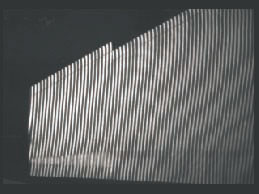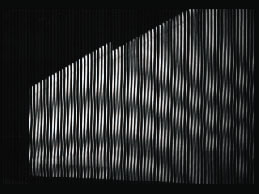| |
Projection Moiré Interferometry
A projection system is used to project a grid of equispaced, parallel lines onto the wind tunnel model surface. The projector system is typically aligned such that its optical axis is perpendicular to the surface being measured. A Ronchi ruling (a transmissive grating with opaque parallel lines etched at equal spacing and thickness) installed in the projector is the physical element generating the projected grid lines. A CCD camera with a narrow bandpass filter matched to the projector illumination wavelength is positioned to view the model at a 30-45 degree angle inclined from the projector optical axis. The projector and camera must lie within a plane perpendicular to the projected grid lines. Images of the grid lines projected onto the model are acquired in baseline (wind-off) and loaded (wind-on) conditions using a frame grabber installed in a PC-compatible computer. An example PMI raw data image is shown in figure 2.

Figure 2.
Image processing routines are then used to remove camera perspective distortion and interfere the acquired images with a computationally generated reference grid, resulting in interferograms containing moiré fringes, figure 3.
These fringe patterns are further processed offline to obtain a quantitative, spatially continuous representation of the model surface shape or deformation, as shown in figure 4.
PMI projector systems can use any incoherent light source for grid line projection. For example, conventional slide projectors are often used in laboratory PMI systems. Unfortunately, commercially available slide, micromirror, or liquid crystal display-type units will not perform adequately for a for a majority of wind tunnel applications. These projectors are often too large to fit into wind tunnel optical access ports, and are not robust enough to withstand the temperature, pressure, and vibration extremes present in most tunnels. These projectors also do not provide the illumination necessary to acquire model deformation measurements in a lighted test section, or enough light intensity to acquire short exposure measurements.

Figure 3.
|




